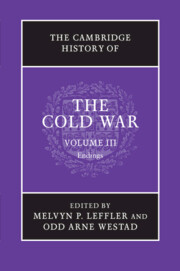Book contents
- Frontmatter
- 1 The Cold War and the intellectual history of the late twentieth century
- 2 The world economy and the Cold War, 1970–1990
- 3 The rise and fall of Eurocommunism
- 4 The Cold War and Jimmy Carter
- 5 Soviet foreign policy from détente to Gorbachev, 1975–1985
- 6 Islamism, the Iranian revolution, and the Soviet invasion of Afghanistan
- 7 The collapse of superpower détente, 1975–1980
- 8 Japan and the Cold War, 1960–1991
- 9 China and the Cold War after Mao
- 10 The Cold War in Central America, 1975–1991
- 11 The Cold War and southern Africa, 1976–1990
- 12 The Gorbachev revolution and the end of the Cold War
- 13 US foreign policy under Reagan and Bush
- 14 Western Europe and the end of the Cold War, 1979–1989
- 15 The East European revolutions of 1989
- 16 The unification of Germany, 1985–1991
- 17 The collapse of the Soviet Union, 1990–1991
- 18 Science, technology, and the Cold War
- 19 Transnational organizations and the Cold War
- 20 The biosphere and the Cold War
- 21 The Cold War and human rights
- 22 The Cold War in the longue durée: global migration, public health, and population control
- 23 Consumer capitalism and the end of the Cold War
- 24 An ‘incredibly swift transition’: reflections on the end of the Cold War
- 25 The restructuring of the international system after the Cold War
- Bibliographical essay
- Index
- References
8 - Japan and the Cold War, 1960–1991
Published online by Cambridge University Press: 28 September 2010
- Frontmatter
- 1 The Cold War and the intellectual history of the late twentieth century
- 2 The world economy and the Cold War, 1970–1990
- 3 The rise and fall of Eurocommunism
- 4 The Cold War and Jimmy Carter
- 5 Soviet foreign policy from détente to Gorbachev, 1975–1985
- 6 Islamism, the Iranian revolution, and the Soviet invasion of Afghanistan
- 7 The collapse of superpower détente, 1975–1980
- 8 Japan and the Cold War, 1960–1991
- 9 China and the Cold War after Mao
- 10 The Cold War in Central America, 1975–1991
- 11 The Cold War and southern Africa, 1976–1990
- 12 The Gorbachev revolution and the end of the Cold War
- 13 US foreign policy under Reagan and Bush
- 14 Western Europe and the end of the Cold War, 1979–1989
- 15 The East European revolutions of 1989
- 16 The unification of Germany, 1985–1991
- 17 The collapse of the Soviet Union, 1990–1991
- 18 Science, technology, and the Cold War
- 19 Transnational organizations and the Cold War
- 20 The biosphere and the Cold War
- 21 The Cold War and human rights
- 22 The Cold War in the longue durée: global migration, public health, and population control
- 23 Consumer capitalism and the end of the Cold War
- 24 An ‘incredibly swift transition’: reflections on the end of the Cold War
- 25 The restructuring of the international system after the Cold War
- Bibliographical essay
- Index
- References
Summary
Japan, along with Germany, played a central role in the Cold War. Both countries fought against the United States and its allies during World War II, and both emerged as key objectives and participants in the contest between the Soviet- and American-led blocs. As early as 1947, Under Secretary of State Dean Acheson declared that Western security required the restoration of these “two great workshops” of Europe and Asia. Yet, in spite of Japan’s dual role as prize and player, it differed in several ways from its European counterpart. Unlike Germany’s Social Democrats, the opposition Socialist Party in Japan rejected the legitimacy of a military alliance with the United States. Also, the insulation provided by its island status made Japanese less fearful than West Germans of a direct military threat from the Soviet Union.
During the early Cold War as well as its later stages, Japan occupied a distinct role vis-à-vis its Western allies and Communist enemies. Always more of an economic than a security partner, Japan formed both a pivot of US–led containment in East Asia and an occasional rival. If the North Atlantic Treaty Organization (NATO) served both to protect West Germany and control it, the United States’ so-called Pacific alliance with Japan similarly embodied a form of “double containment.” US forces in and around Japan shielded it from external threats while also tethering Japan, lest it slip from Washington’s orbit and gravitate toward neutralism or something worse.
- Type
- Chapter
- Information
- The Cambridge History of the Cold War , pp. 156 - 180Publisher: Cambridge University PressPrint publication year: 2010
References
- 2
- Cited by

